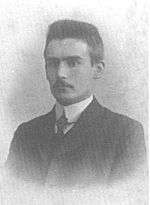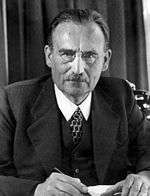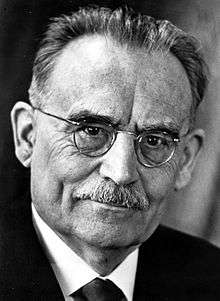Willem Drees
| His Excellency Willem Drees | |
|---|---|
 Willem Drees in 1950 | |
| Prime Minister of the Netherlands | |
|
In office 7 August 1948 – 22 December 1958 | |
| Monarch |
Wilhelmina (1948) Juliana (1948–1958) |
| Deputy |
See list
|
| Preceded by | Louis Beel |
| Succeeded by | Louis Beel |
| Leader of the Labour Party | |
|
In office 9 February 1946 – 22 December 1958 | |
| Preceded by | Position established |
| Succeeded by | Jaap Burger |
| Minister of Finance | |
|
In office 1 July 1952 – 2 September 1952 | |
| Prime Minister | Himself |
| Preceded by | Piet Lieftinck |
| Succeeded by | Johan van de Kieft |
| Minister of Colonial Affairs | |
|
In office 15 March 1951 – 31 March 1951 | |
| Prime Minister | Himself |
| Preceded by | Johan van Maarseveen |
| Succeeded by | Leonard Antoon Peters |
| Deputy Prime Minister of the Netherlands | |
|
In office 24 June 1945 – 7 August 1948 | |
| Prime Minister |
Willem Schermerhorn (1945–1946) Louis Beel (1948) |
| Preceded by | Position established |
| Succeeded by | Josef van Schaik |
| Minister of Social Affairs | |
|
In office 24 June 1945 – 7 August 1948 | |
| Prime Minister |
Willem Schermerhorn (1945–1946) Louis Beel (1948) |
| Preceded by | Dolf Joekes |
| Succeeded by | Frans Wijffels |
| Leader of the Social Democratic Workers' Party | |
|
In office 14 May 1940 – 9 February 1946 | |
| Preceded by | Willem Albarda |
| Succeeded by | Position abolished |
| Leader of the Social Democratic Workers' Party in the House of Representatives | |
|
In office 5 September 1939 – 24 June 1945 | |
| Preceded by | Willem Albarda |
| Succeeded by | Position abolished |
| Member of the House of Representatives | |
|
In office 3 July 1956 – 3 October 1956 | |
|
In office 15 July 1952 – 2 September 1952 | |
|
In office 27 July 1948 – 10 August 1948 | |
|
In office 4 June 1946 – 4 July 1946 | |
|
In office 9 May 1933 – 24 June 1945 | |
| Personal details | |
| Born |
Willem Drees 5 July 1886 Amsterdam, Netherlands |
| Died |
14 May 1988 (aged 101) The Hague, Netherlands |
| Nationality | Dutch |
| Political party | Labour Party (1946–1971) |
| Other political affiliations | Social Democratic Workers' Party (1904–1946) |
| Spouse(s) |
Catharina Hent (m. 1910; d. 1974) |
| Children |
Annie Drees (1911–2002) Adriana Drees (1914–1920) Jan Drees (1919–2002) Willem Drees Jr. (1922–1998) |
| Occupation |
Politician Civil servant Accountant Stenographer Bank teller Historian Author |
| Signature |
|
Willem Drees Sr. (![]()
Born in Amsterdam, Drees, a civil servant and accountant by occupation, worked as a bank teller from 1903 until 1906 and as a stenographer for the States General of the Netherlands from 1907 until 1945. He served as a member of the House of Representatives from 9 May 1933 to 24 June 1945 while retaining his previous employment. In October 1940 he was taken hostage in Buchenwald concentration camp for resisting orders given by German occupiers but was freed one year later; his parliamentary mandate had not been revoked. He served as the parliamentary leader of the Social Democratic Workers' Party in the House of Representatives from 19 August 1939 until 24 June 1945 when he became Minister of Social Affairs and Deputy Prime Minister serving from 24 June 1945 until 7 August 1948 in the Schermerhorn-Drees cabinet and First Beel cabinet. He served again a short periode as a member of the House of Representatives, after the general election of 1946 from 4 June 1946 until 4 July 1946. After the general election of 1948, Drees became Prime Minister of the Netherlands, leading the First, Second, Third and Fourth Drees cabinets. He also served as Acting Minister of Colonial Affairs from 15 March 1951 until 31 March 1951 and as Acting Minister of Finance from 1 July 1952 until 2 September 1952, following the resignations of Johannes Henricus van Maarseveen and Piet Lieftinck respectively. He again had two short stints as a member of the House of Representatives after the general election of 1952 and 1952, serving from 15 July 1952 until 2 September 1952 and from 3 July 1956 until 3 October 1956.[1]
After his premiership, Drees retired from active politics. He was already seventy-two and second oldest person who served as Prime Minister of the Netherlands after Johan Rudolph Thorbecke, who died in office at the age of seventy-four. On 22 December 1958 he was granted the honorary title of Minister of State. He remained a very active observer of Dutch politics, publishing a substantial number of books and articles until the age of ninety-seven.[2] Willem Drees was the longest-lived Dutch Prime Minister, dying at the age of 101 years, 314 days,[3] on 14 May 1988 in The Hague. He is praised by many as the most important Dutch politician after World War II for his important contributions and social reforms laws and seen as the father of the modern welfare state in the Netherlands.[4][5] Drees was chosen as the best Prime Minister of the Netherlands after World War II after an opinion polling conducted by the VPRO in 2006.[6]
Early years
Willem Drees was born in Amsterdam on 5 July 1886. After completing his secondary education in 1903 he worked until 1906 for the Twentsche Bank in Amsterdam. This was followed by a period as a stenographer with the Municipal Council of Amsterdam and then between 1907 and 1919 with the States General of the Netherlands.
Political involvement
Early political career

In 1904 he joined the Social Democratic Workers' Party, which later was absorbed into the Labour Party in 1946. From 1910 to 1931 he was chairman of The Hague branch of the Social Democratic Workers' Party and between 1913 and 1941 a member of the Municipal Council of The Hague. During that period he was alderman for social affairs from 1919 to 1931 and for finance and public works through to 1933.[2]
For 22 years between 1919 and 1941 Drees also held a seat on the Provincial Council of South Holland and for 19 years between 1927 and 1946 one on the Social Democratic Workers' Party executive. Between 1933 and 1940 he represented the Social Democratic Workers' Party in the House of Representatives and from 1939 as leader in the House of Representatives
During the German occupation he was taken hostage in Buchenwald concentration camp in October 1940. Freed one year later, he played a prominent role, as vice chairman and acting chairman of the illegal Executive Committee of the SDAP, and as a prominent participant in secret interparty consultations. In 1944 he became chairman of the Contact Commissie van de Illegaliteit and a member of the College van Vertrouwensmannen which the government in exile charged with the preparation of steps to be taken at the time of liberation.
Thereafter, from 24 June 1945 to 7 August 1948 Drees was Minister of Social Affairs and Deputy Prime Minister in the Cabinet Schermerhorn/Drees.
Prime Minister of the Netherlands


From 7 August 1948 to 22 December 1958 he was Prime Minister of the Netherlands in four successive cabinets: First Drees cabinet, Second Drees cabinet, Third Drees cabinet and Fourth Drees cabinet.
Drees's period in office saw at least four major political developments: the traumas of decolonisation, economic reconstruction, the establishment of the Dutch welfare state,[7][8] and international integration and co-operation, including the formation of Benelux, the OEEC, NATO, the ECSC, and the EEC. When his Cabinet broke up in December 1958, he was appointed to the honorary position of Minister of State, the Labour Party appointed him a member of its Executive Council for life in 1959. Due to impaired hearing he stopped attending its meetings in 1966. He strongly disagreed with New Left tendencies in the membership and strategies of the Labour Party. He eventually gave up membership of a party he had served for close to 67 years.
Drees was an Esperantist and addressed the 1954 World Congress of Esperanto, which was held in Haarlem.[9]
A wide range of social reforms were carried out during's Drees's tenure as Prime Minister. The Occupational Pensions Funds Act of March 1949 made membership of industry-wide pension funds compulsory, while the General Old Age Pensions Act of May 1956 introduced universal flat-rate old age pensions for all residents as a right and with no retirement condition at the age of 65. The Retired Persons' Family Allowances Act of November 1950 established a special allowance for pensioned public servants with children, a law of November 1950 extended compulsory health insurance to cover other groups, such as old-age and invalidity pensioners, and a law of December 1956 introduced health insurance with special low contributions for old-aged pensioners below a certain income ceiling. A law of August 1950 established equal rights for illegitimate children, and introduced an allowance for disabled children between the ages of 16 and 20. The Temporary Family Allowances Act for the Self-employed of June 1951 entitled self-employed persons with low incomes to family allowance for the first and second child, and a law of February 1952 introduced an allowance for studying and for disabled children until the age of 27.[10] In 1950, works councils were established,[11] and in 1957 the dismissal of female civil servants upon marriage was abolished.[12]
In the field of housing, the Implementation for Rent Act (1950) fixed rents and rent increases, while the Regional and Town Planning Act (1950) regulated the planning of house building. In addition, the Reconstruction Act of 1950 established housebuilding programmes,[13] and legislation was passed on house building standards (1951), the uniformity of buildings (1954), and uniform building standards (1956).[14] In education, measures were carried out such as increased expenditure on the system, a reduction in registration fees at State universities and at the institute of technology,[13] and the granting (in January 1956) of a special benefit to primary school teachers and to certain categories of vocational teachers, "particularly those who risk being unemployed and who cannot lay claim to a retaining fee."[15] Other initiatives included secondary schools for girls and special primary education in 1949, teacher training colleges in 1952,[16] the extension of compulsory education to 8 years in 1950,[17] and the Nursery Education Act of 1955, which introduced the option of kindergarten for children from the age of four upwards, while also establishing regulations for nursery-school teachers.[10] A department of social welfare was also established (1952), while laws were passed on unemployment benefits (1952) and a widows' and orphans' pension (1956).[14]
Personal life
.jpg)
On 28 July 1910, Drees married Catharina Hent (6 May 1888 – 30 January 1974)[18][19] and had two sons and two daughters, Both his sons Jan Drees and Willem Drees Jr. were active members of the Labour Party, but left the party around 1970 to join the Democratic Socialists '70. The cause was a row with younger party members who wanted to plot a more radical left-wing course for the party. Drees himself left the Labour Party in 1971 leaving them without their icon, but he never joined the Democratic Socialists '70.
Drees was a Teetotaler. Willem Drees died on 14 May 1988 in The Hague, two months before his 102nd birthday.[20] From 22 August 1986, when former Turkish President Celâl Bayar died until his own death, Drees was the world's oldest living former head of state.
In 2004 he ended in third place in the election of The Greatest Dutchman.[21][22]
Further reading
Four Volume Biography Willem Drees 1886-1988, in Dutch:
- Jelle Gaemers, De rode wethouder: De jaren 1886-1940" (Amsterdam: Balans, 2006).637 pp. ISBN 90 5018 760 9.
- Hans Daalder, Gedreven en behoedzaam: De jaren 1940-1948 (Amsterdam: Balans, 2003). 528 pp. ISBN 90 5018 6157.
- Hans Daalder, Vier jaar nachtmerrie: De Indonesische kwestie (Amsterdam: Balans, 2004). 548 pp. ISBN 90 5018 639 4.
- Hans Daalder en Jelle Gaemers, Premier en elder statesman: De jaren 1948-1988 (Amsterdam: Balans, 2014). 640 pp. ISBN 978 94 600 3715 3.
- W. Drees, Gespiegeld in de tijd. De nagelaten autobiografie (Amsterdam 2000). (Memoir by Willem Drees, Jr.)
Decorations
- Order of the Netherlands Lion
- Knight Grand Cross (22 December 1958)
- Medal of Freedom with gold palm (7 April 1953)
References
- ↑ "The Encyclopedia Americana". Grolier. 18 November 1992 – via Google Books.
- 1 2 (in Dutch) Biography Willem Drees BWSA
- ↑ Mcwhirter, Norris; McFarlan, Donald (18 November 1989). "the Guinness Book of Records 1990". Guinness Publishing Ltd – via Google Books.
- ↑ (in Dutch) Geschiedenis VPRO Geschiedenis 24.
- ↑ (in Dutch) Willem Drees beste crisismanager Geencommentaar.nl.
- ↑ (in Dutch) Willem Drees gekozen tot ‘Dé premier na WO II’ Geschiedenis 24.
- ↑ Orlow, D. (2000). Common Destiny: A Comparative History of the Dutch, French, and German Social Democratic Parties, 1945-1969. Berghahn Books. p. 120. ISBN 9781571812254. Retrieved 2017-01-13.
- ↑ Lentz, H.M. (2014). Heads of States and Governments Since 1945. Taylor & Francis. p. 578. ISBN 9781134264902. Retrieved 2017-01-13.
- ↑ UEA: Reta Muzeo. Materialoj el Biblioteko Hector Hodler. 1947-1974 World Esperanto Association.
- 1 2 Growth to Limits: The Western European Welfare States Since World War II, Volume 2 edited by Peter Flora.
- ↑ Wilkinson, A.; Donaghey, J.; Dundon, T.; Freeman, R.B. (2014). Handbook of Research on Employee Voice: Elgar original reference. Edward Elgar Publishing. p. 68. ISBN 9780857939272. Retrieved 2017-01-13.
- ↑ http://nidi.knaw.nl/shared/content/output/2002/ssm-54-05-fokkema.pdf
- 1 2 Moore, B.; van Nierop, H. (2006). Twentieth-Century Mass Society in Britain and the Netherlands. Bloomsbury Academic. p. 60. ISBN 9781845205256. Retrieved 2017-01-13.
- 1 2 van Heffen, O.; Kickert, W.J.M.; Thomassen, J. (2013). Governance in Modern Society: Effects, Change and Formation of Government Institutions. Springer Netherlands. ISBN 9789401594868. Retrieved 2017-01-13.
- ↑ http://unesdoc.unesco.org/images/0013/001329/132929eo.pdf
- ↑ Wolthuis, J. (1999). Lower Technical Education in the Netherlands 1798-1993: The Rise and Fall of a Subsystem. Coronet Books Incorporated. p. 202. ISBN 9789053508619. Retrieved 2017-01-13.
- ↑ Hindman, H.D. (2009). The World of Child Labor: An Historical and Regional Survey. M.E. Sharpe. p. 635. ISBN 9780765626479. Retrieved 2017-01-13.
- ↑ "Graftombe.nl - Informatie over Catharina Hent". www.graftombe.nl.
- ↑ "SeniorPlaza - Willem Drees". seniorplaza.nl.
- ↑ "Willem Drees Dies at 101; Postwar Dutch Leader". The New York Times. 19 May 1988.
- ↑ (in Dutch) 'Pim Fortuyn toch niet de Grootste Nederlander' NU.nl
- ↑ (in Dutch) Zoektocht naar ‘Grootste Nederlander’ begint Geschiedenis24
External links
![]()
- Official
- (in Dutch) Dr. W. (Willem) Drees Parlement & Politiek
- (in Dutch) Kabinet-Drees-Van Schaik Rijksoverheid
- (in Dutch) Kabinet Drees I Rijksoverheid
- (in Dutch) Kabinet-Drees II Rijksoverheid
- (in Dutch) Kabinet-Drees III Rijksoverheid
| Party political offices | ||
|---|---|---|
| Preceded by Willem Albarda |
Parliamentary leader of the Social Democratic Workers' Party in the House of Representatives 1939–1945 |
Party dissolved |
| Leader of the Social Democratic Workers' Party 1940–1946 | ||
| New title | Leader of the Labour Party 1946–1958 |
Succeeded by Jaap Burger |
| Political offices | ||
| Preceded by Dolf Joekes |
Minister of Social Affairs 1945–1948 |
Succeeded by Frans Wijffels |
| New title | Deputy Prime Minister of the Netherlands 1945–1948 |
Succeeded by Josef van Schaik |
| Preceded by Louis Beel |
Prime Minister of the Netherlands 1948–1958 |
Succeeded by Louis Beel |
| Minister of General Affairs 1948–1958 | ||
| Preceded by Johan van Maarseveen |
Minister of Colonial Affairs 1951 |
Succeeded by Leonard Antoon Peters |
| Preceded by Piet Lieftinck |
Minister of Finance 1952 |
Succeeded by Johan van de Kieft |
